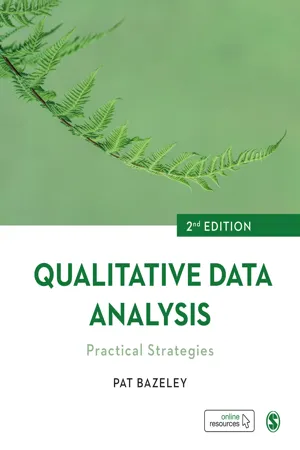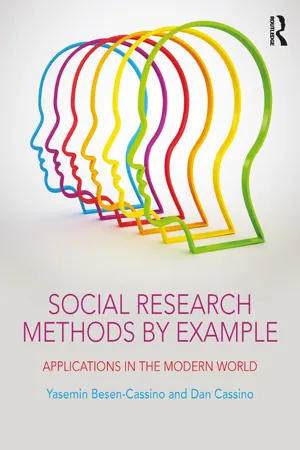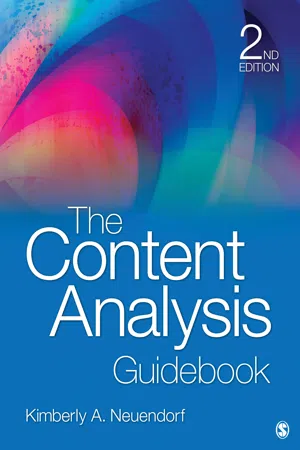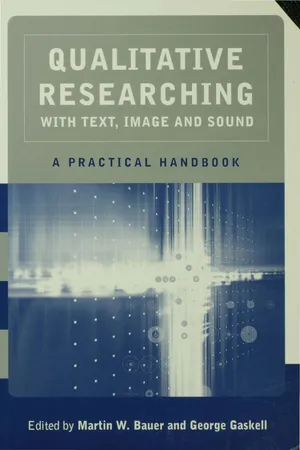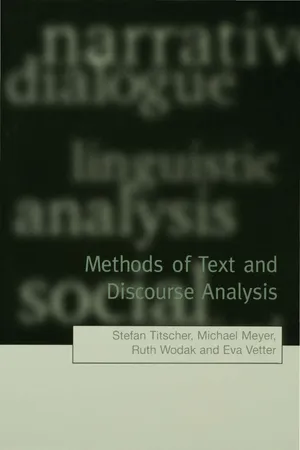Social Sciences
Content Analysis in Sociology
Content analysis in sociology involves systematically analyzing the content of various forms of communication, such as written, verbal, or visual materials, to identify patterns, themes, and meanings. Researchers use this method to study social phenomena, media representations, and cultural trends. By examining the underlying messages and symbols, content analysis provides insights into societal values, power dynamics, and social structures.
Written by Perlego with AI-assistance
Related key terms
9 Key excerpts on "Content Analysis in Sociology"
- eBook - ePub
Applied Communication Research Methods
Getting Started as a Researcher
- Michael Boyle, Mike Schmierbach(Authors)
- 2019(Publication Date)
- Routledge(Publisher)
social artifacts. The example of measuring negativity in ads is one case in which content analysis might be used, but there are many others. For example, content analysis could also be used to see whether news programs give more time to Democrats than Republicans, whether advertisements are more likely to show White consumers than those of other races, or whether video games tend to show women as more sexualized than men. Content analysis is even used when researchers want to convert open-ended items from surveys or other research projects into quantitative data describing basic patterns in participant responses.survey → Unit 10 experiment → Unit 9 causality → Unit 2 systematic → Unit 1 variable → Unit 2 open-ended → Unit 7 population → Unit 8 sample → Unit 8 qualitative versus quantitative → Unit 3 reliability → Unit 6 reactive → Unit 7 depth interviews → Unit 12 transcript → Unit 13Content analysis most frequently involves the same basic process as all systematic research. First, you must identify the population of texts you wish to study and then draw an appropriate sample from that population. Next, you must engage in a systematic process of observation to measure the relevant variables within that population and evaluate whether your measurement approach is effective. Finally, you are left with data (most often quantitative) that can be analyzed the same as any other research outcomes, as we will discuss in a later unit.Content analysis does have certain characteristics that differ from other types of research, though. First, content analysis requires researchers to pay attention to the unitizing - eBook - ePub
Getting Started in Your Educational Research
Design, Data Production and Analysis
- Clive Opie, Desma Brown(Authors)
- 2019(Publication Date)
- SAGE Publications Ltd(Publisher)
Some common concerns expressed by students have revolved around the analysis of qualitative data, particularly at the stages of planning their research and when data has been collected. Qualitative data analysis can prove to be something of a challenge, particularly as the diversity of that data makes analysis complex (Newby, 2014: 458). You may find yourself in the position of having various data sets, e.g. recordings of talk, visual images, or observations etc. It is therefore useful to have some understanding of the different options that might be available to you when thinking about how you are going to analyse your qualitative data. The task of analysis involves you having to make decisions about how the data might be categorised or organised, in order to cast some understanding about the research area under investigation. You may find the following approaches to the analysis of qualitative data useful, but by gaining some understanding of their function you will be able to make judgements about how to analyse your own data. We begin the chapter with a discussion by Hannah Scaife of the process of analysing and interpreting textual data in Content Analysis, followed by a consideration of the exploration of themes within data through Thematic Analysis, the tool which she used in the completion of her Master’s degree in psychology (Scaife, 2016). Then Desma Brown examines what is understood by the term Discourse Analysis, exploring the research for her own doctorate (Brown, 2016) as an example of its usage. This is then followed by an insight into Critical Discourse Analysis and Conversation Analysis and how they might be useful should you decide to examine discourse as part of your study.Content Analysis
What is Content Analysis and how is it used?
Content Analysis is a method for analysing and interpreting textual data, using coding and categorisation to identify the presence and frequency of trends and patterns (Ahuvia, 2001; Bauer, 2000; Gbrich, 2007; Mayring, 2000; Pope et al., 2006).Textual data can be viewed according to one or more of five distinctions (Krippendorff, 2013):- Physical – mechanisms used to structure a physical medium, e.g. books, newspapers, photographs, interview transcripts, letters.
- Syntactical – ‘naturally’ occurring blocks of data, e.g. chapters in a book, articles in a magazine, scenes in a film, individual words within a transcript.
- Categorical
- eBook - ePub
Qualitative Data Analysis
Practical Strategies
- Patricia Bazeley(Author)
- 2020(Publication Date)
- SAGE Publications Ltd(Publisher)
Content analysis of visual materials, in the form of counted frequencies with which selected visual elements or signs appear in a set of visual images, is a systematic method used for analysing trends over time or across different settings, primarily in studies of mass media (Bell, 2001). For example, to explore the dehumanisation of refugees in Australia, Bleiker, Campbell, Hutchison, and Nicholson (2013) reviewed 87 front-page pictures of asylum-seekers in two major newspapers over two critical time periods, looking only to see how many people were shown in each image, and whether or not you could discern the faces of those shown.Questions addressed by content analysis are clearly focused, sometimes stated as hypotheses. Sampling decisions are important, and what is to be coded is determined early in the process and then adhered to throughout. The sampling method and frame (inclusion/exclusion criteria) need to be clearly specified for both design and reporting purposes. Categories for coding need to be exhaustive, covering all content relevant to the research question, and, similarly, clearly defined and discrete (Bock, Isermann, & Knieper, 2011). As coding of visual data for content analysis remains an interactive (rather than automated) process (although potentially supported by QDAS or other data-management software), the reliability of coding is usually assessed. The meaning of pictures can be affected by the communication context in which they appear, and so information about that also needs to be noted. This includes both the physical context in which the items appear, and the social context, for example the protocols, or rules of behaviour, that govern the settings in which a set of photographs were taken (Bock et al., 2011).Content analysis is usually thought of as being more of a quantitative than qualitative method as the method generates counts which are usually analysed statistically. It typically neglects the meaning of the image – its ‘latent’ content (Banks, 2018). However, in qualitative and mixed methods studies a form of content analysis is often used as a first stage of a project to provide an overview of the available material, to then be followed up by a semiotic or discourse-style analysis (as in the Greenwood et al. study described in Example 11.2 - eBook - ePub
Introducing Research Methodology
Thinking Your Way Through Your Research Project
- Uwe Flick(Author)
- 2020(Publication Date)
- SAGE Publications Ltd(Publisher)
In the second part of the chapter, we will have a look at some qualitative approaches to analyzing data, including qualitative content analysis. Quantitative Content Analysis Content analysis is a classical procedure for analyzing textual material of whatever origin, from media products to interview data. It is ‘an empirical method for systematic, inter-subjectively transparent description of substantial and formal features of messages’ (Früh 1991, p. 25). The method is based on using categories derived from theoretical models. One normally applies such categories to texts, rather than develop them from the material itself – though one may of course revise the categories in the light of the texts under analysis. Content analysis aims at classifying the content of texts by allocating statements, sentences or words to a system of categories. This approach distinguishes between quantitative and qualitative content analyses, which we will address later. Analyzing newspaper articles While qualitative content analysis is seen as a method of analyzing data from interviews (see below), for example, some sources see quantitative content analysis rather as a specific method for collecting data (e.g. Bortz and Döring 2006; Bryman 2016). Schnell et al. (2008, p. 407) see the method as ‘a mixture of “analytic technique” and data collection procedure’. It is used for collecting and classifying information, such as in newspaper articles. Bortz and Döring provide the following as a definition: ‘Quantitative content analysis captures particular features of text by categorizing parts of the text into categories, which are operationalizations of the interesting features. The frequencies of the single categories inform features of the analyzed text’ (2006, p - eBook - ePub
- Gwen Bouvier, Joel Rasmussen(Authors)
- 2022(Publication Date)
- Routledge(Publisher)
Rather, the data is usually of a qualitative nature; it is created from the beginning through complex, institutional processes in a certain socio-historical context, and understanding it requires interpretation and contextual consideration. Kracauer thus concludes that, because texts are not atomistic phenomena but created and made meaningful in contexts, a qualitative analytical approach is necessary for content analysis research to be able to draw general conclusions. From its establishment in communication studies, the method has since been further developed in various disciplines. This means that there is a certain variation in understanding what the method represents. On the one hand, it is common to come across a precise definition such as that by Schreier (2014: 170), stating that “[q]ualitative content analysis is a method for systematically describing the meaning of qualitative data. … Three features characterize the method: qualitative content analysis reduces data, it is systematic, and it is flexible.” On the other hand, there is also an understanding of QCA as a general, qualitative approach, as evidenced by a widely cited definition from Patton (2002: 453), stating that QCA “is any qualitative data reduction and sense-making effort that takes a volume of qualitative material and attempts to identify core consistencies and meanings.” Based on this latter understanding, it becomes difficult to perceive any difference between qualitative, descriptive methods, such as thematic analysis and QCA. There may thus be a point in trying to follow Schreier (2012, 2014) and develop the specificity of QCA. The historical background and the argument by Kracauer (1952) in favor of QCA indicates that its value lies in recognizing communication as meaning making, and that the analysis allows a combination of systematic procedures and flexibility, countable categories and context-sensitive interpretation - eBook - ePub
Social Research Methods by Example
Applications in the Modern World
- Yasemin Besen-Cassino, Dan Cassino(Authors)
- 2017(Publication Date)
- Routledge(Publisher)
In terms of ethical considerations, content analysis is one of the easiest research methods to deal with. Because principal investigators are not dealing with human subjects, but rather using recorded material, they are not required to apply to their IRBs for approval before starting their research projects. Because content analysis uses secondary data, which already exists in recorded material, it does not use human subjects. Therefore, with content analysis, there is no potential harm to human subjects. In recent years, however, researchers have started to debate the potential harm in content analysis. Content analysis does not directly deal with human subjects, but it might indirectly cause potential harm by violating their privacy. Think about the study of Christie’s novels. Based on the content analysis of her novels, the researchers concluded that Christie might have had Alzheimer’s disease. Given that the author is deceased, what are the ethical obligations of the researcher? It is certainly possible to uncover something during content analysis that the author might be trying to keep private. Therefore, even though we do not typically think of content analysis as potentially harming human subjects, it is important to keep in mind that individuals potentially can be harmed. Researchers still need to be cautious of issues of privacy.ADVANTAGES AND DISADVANTAGES OF CONTENT ANALYSIS
Content analysis has many advantages. Unlike many other techniques we studied in this book, content analysis is the only technique that does not directly deal with people. In-depth interviews, surveys, and experiments all focus on the individual participant or respondent: asking questions; recording the participant’s reactions, behavior, attitudes, or values. Content analysis, however, systematically studies patterns in printed or visual media. There are some research questions that can only be answered with this method. Do cartoons use aggressive messages? Do advertisements use more white models than African American models? Do presidential speeches use religious messages? These are not questions researchers can answer by directly asking individual people. If researchers want to capture the nonliving portion of culture, content analysis provides them with the tools to systematically analyze it.Content analysis is especially useful in women and gender studies. Many feminist scholars argue that historical reports are biased because they come from the perspective of men. Using historic artifacts, diaries, letters, and women’s narratives, many feminist scholars conduct content analysis to capture the perspectives of women. Women’s perspectives have historically been marginalized; content analysis sheds light on these untold stories.Content analysis is also an unobtrusive measure - eBook - ePub
- Kimberly A. Neuendorf(Author)
- 2016(Publication Date)
- SAGE Publications, Inc(Publisher)
summarized the state of news reporting across the sample of 297 stories.5. Content Analysis as Applicable to All Contexts
The term content analysis is not reserved for studies of mass media or for any other type of message content or context. As long as other pertinent characteristics apply (e.g., quantitative, summarizing), the study of any type of message pool may be deemed a content analysis. The messages may be mediated—that is, having some message reproduction or transmittal device interposed between source and receiver. Or they may be nonmediated—that is, experienced face to face. Although not attempting to create an exhaustive typology of communication purposes and context, the sections to follow give some examples of the range of applications of the techniques of content analysis.Individual Messaging
Some analyses examine the creation of messages by a single individual, with the typical goal of making some inference to that source (Chapter 2 will provide further discussion regarding limits to the ability to make inferences from content analysis findings).In psychology, there is a growing use of content analysis of naturally produced text and speech as a type of psychometric instrument (Gottschalk, 1995; Gottschalk & Bechtel, 2008; Horowitz, 1998; Tully, 1998). This technique analyzes statements made by an individual to diagnose psychological disorders and tendencies, to measure psychological traits of the source, or to assess the credibility of the source (Doris, 1994). Nearly all these efforts stem from the work of Philip Stone (Stone et al., 1966) in the Harvard Department of Social Relations. His “General Inquirer” computer program was the first to apply content-analytic techniques to free-speech words (see “Milestones in Content Analysis History” at The Content Analysis Guidebook Online, CAGO - eBook - ePub
Qualitative Researching with Text, Image and Sound
A Practical Handbook for Social Research
- Martin W Bauer, George Gaskell(Authors)
- 2000(Publication Date)
- SAGE Publications Ltd(Publisher)
As usual, interviews should be recorded and the researcher should ensure that references to parts of the material are explicit for later reference. This is made easier if a video recording of the material is made, and participants are encouraged to point to the relevant part of the material as they speak. The transcript would then be coded thematically, perhaps with reference to a prior semiological account.Content analysis
Semiology and content analysis are often held to be radically different analytic tools, but, as both Leiss et al. (1997) and Curran (1976) argue, there is plenty of scope for a rapprochement. Semiologists may import the systematic sampling procedures of content analysis. This will go some way towards addressing the criticisms that the approach manufactures self-confirming results and that it is not legitimate to generalize the conclusions of a semiological analysis to other material. The sharper systematization of analysis that content analysis advocates may also help the semiologist to combat charges of selectivity (for example in generating denotational inventories and matrices of potential syntagms). The resulting analyses should be more reliable (replicable) and less prone to the idiosyncrasies and skill of a given analyst.In addition, the inclusion of more interpretive codes (based on connotation rather than denotation) in content analyses is evidence of the reciprocal influence of semiology. However, such analyses lose the structural aspects of a purely semiological approach: how meaning is created in the spatial relationships among elements within the individual image. However, this manner of exposition, even in the hands of the most adept and laconic of researchers, requires a vast amount of space if the analysis is to cover even a fraction of the standard sample size routinely entertained by the content analyst. The major obstacle to a complete integration of the two approaches is thus logistical. The solution might be to employ the two approaches side-by-side. A semiological account of a small sample of images may exemplify different content analytic codes. For example, a content analytic code relating to, say, ‘myths of beauty’, applied quantitatively to a large sample of advertisements, might be illustrated qualitatively by a semiological account of the present advertisement. This account would be partial in that it would focus on relevant aspects of the image rather than analyse the entire advertisement. It would enhance the transparency of the content analytic procedure by making the method and criteria of coding explicit and open to examination by the reader. - eBook - ePub
Methods of Text and Discourse Analysis
In Search of Meaning
- Stefan Titscher, Michael Meyer, Ruth Wodak, Eva Vetter(Authors)
- 2000(Publication Date)
- SAGE Publications Ltd(Publisher)
Handbook of Social Psychology (Lindzey & Aronson 1985) there is no entry for content analysis. In place of this the authors have included a more general account by Clark (1985), ‘Language Use and Language Users’, which also outlines linguistic theories and methods (such as speech act analysis, conversation analysis). It can even be seen from the heyday of secondary publications on content analysis – the 1970s and early 1980s – that the lifecycle of the method has passed its peak and that a phase of differentiation has now begun.Herkner, Werner (1974), ‘Inhaltsanalyse’, in Jürgen von Koolwijk & Maria Wieken-Mayser (eds), Techniken der empirischen Sozialforschung, vol. 3, München: Oldenbourg, 158–91.Herkner’s contribution to this manual gives a comprehensive overview of the emphases, the theoretical foundations and the procedures employed in content analysis research.Holsti, Ole R. (1968), ‘Content Analysis’, in Gardner Lindzey & Elliot Aronson (eds), The Handbook of Social Psychology, (2nd edn), vol. 2, Research Methods, Reading: Addison-Wesley, 596–692.Holsti provides, almost as a summary of his methodological book (1969), an overview of essential questions and procedures used in content analysis.Mayring, Philip (1991), ‘Qualitative Inhaltsanalyse’, in Uwe Flick, Ernst von Kardorff, Heiner Keupp, Lutz von Rosenstiel and Stefan Wolff (eds), Handbuch Qualitative Sozialforschung, München: Psychologie-Verlags-Union, 209–13.Philip Mayring’s contribution, which briefly outlines his ‘qualitative content analysis’, is included in this German manual of qualitative social research.Silbermann, Alphons (1974), ‘Systematische Inhaltsanalyse’, in René König (ed.), Handbuch der empirischen Sozialforschung, vol. 4, Komplexe Forschungsansatze, Stuttgart: Enke, 253–339.Alphons Silbermann’s contribution is particularly impressive for its thorough presentation of the historical development of the method. As fields of application, Silbermann describes the analysis of cultural and social thought systems, literary analysis, the analysis of stereotypes and symbolic representations, and the use of content analysis in warfare and politics. An overview of content analysis research in mass communication is followed by a section on the further development of the method and a short account of techniques.
Learn about this page
Index pages curate the most relevant extracts from our library of academic textbooks. They’ve been created using an in-house natural language model (NLM), each adding context and meaning to key research topics.


